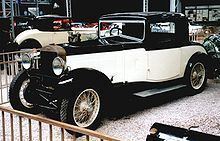Industry Manufacturing Ceased operations 1931 | Defunct 1931 Founded 1920 | |
 | ||
Products Automobiles,pneumatic engineering(subsequently) aircraft landing gear | ||
Messier was a French automobile manufacturer, based at Montrouge, on the southern edge of Paris, from 1925 till 1931.
Contents
Origins
George Messier owned a factory for "pneumatic equipment" at least as early as 1920. He also developed a type of air suspension for automobiles. In 1920 he created the company Messier Automobiles and marketed the air suspension. From 1925 he produced automobiles on his own account, using the Messier name. In 1931 Messier abandoned automobile production in order to concentrate, primarily, on aircraft landing gear.
At least one source claims that Messier's air suspension was the basis for the revolutionary Hydropneumatic suspension of later Citroën models including, most notably, the 1955 DS. The inventor of the Hydropneumatic suspension, Paul Magès, was born in 1908, so it is technically possible that he saw the glimmer of a good idea in the Messier and spent WW2 focused on intensive experimentation to improving the idea. He eventually used pressurized oil, not air, as the springing mechanism.
The cars
The notable feature of the cars was their Air suspension. The engines were bought in from specialist engine manufacturers. The first cars used a 4-cylinder engine from CIME. There was a racing model powered by a 1494cc overhead camshaft unit while Touring and Limousine bodied 4-cylinder cars were fitted with a 1598cc overhead camshaft unit. In October 1924 the manufacturer took a stand at the 19th Paris Motor Show, preparing to market his small cars during the 1925 model year. They were advertised as "voitures sans ressorts" (cars without springs), highlighting the unconventional pneumatic suspension. In place of springs the cars featured above each front wheel pneumatic tubes of compressed air, each of 6 cm (2 in) diameter. Similar tubes were fixed in place of the rear suspension, shorter than the tubes at the front, but also slightly thicker, each having a 7 cm (3 in) diameter.
By October 1928, it was clear from the cars exhibited on the Messier stand at the 22nd Paris Motor Show that the manufacturer had "changed class". There were 6-cylinder cars with engine capacities of 2770cc and 3310cc and 8-cylinder models of 3692cc (20CV) and 4850cc (30CV). The largest engines came from Lycoming Engines of Pennsylvania, and engines from other American suppliers were also used.
The 8-cylinder "Messier Type H" was offered with two alternative wheelbase lengths of respectively 3,400 mm (134 in) and 3,600 mm (142 in). 50 were produced: many of them were fitted with ambulance bodies.
